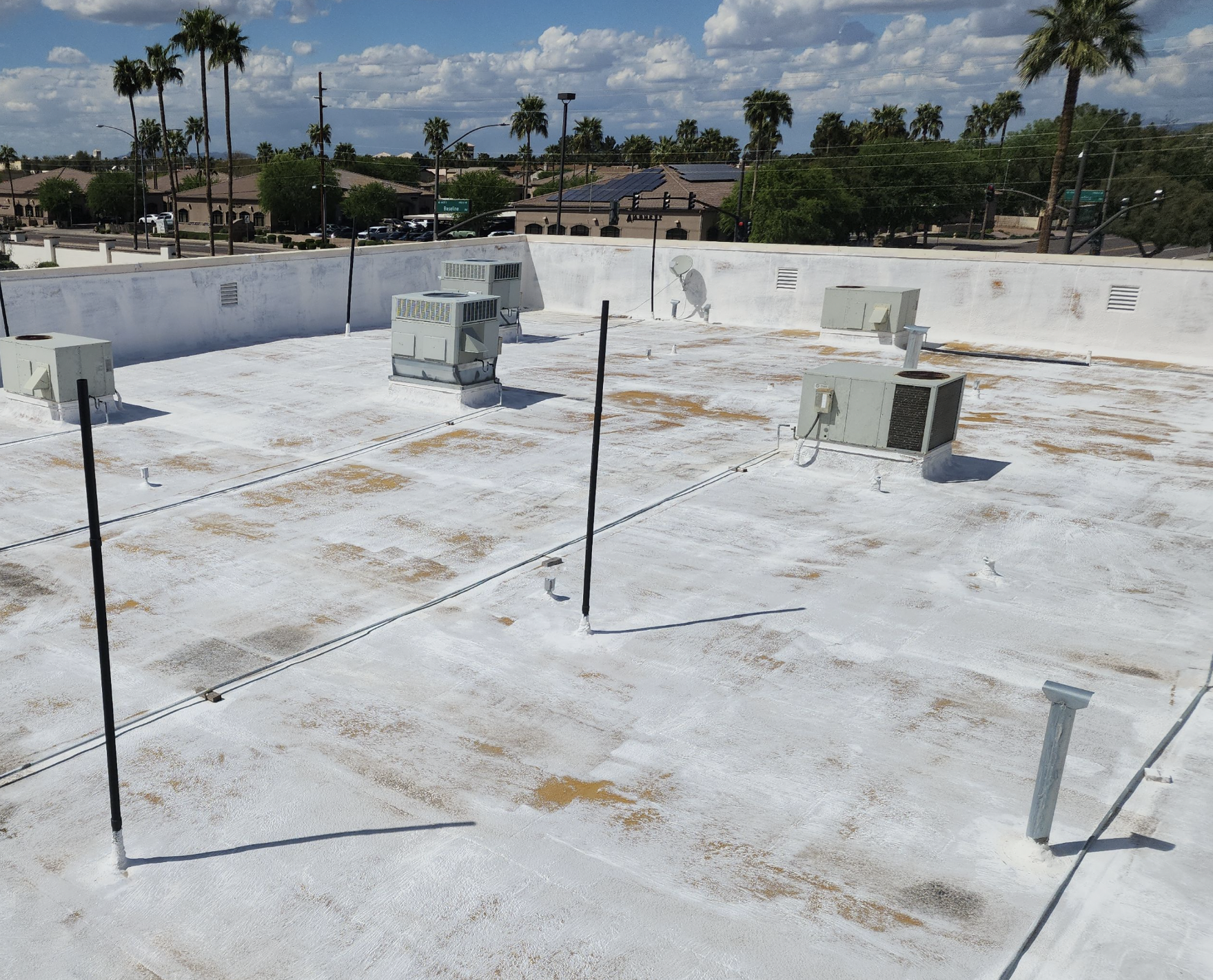
Everything you wanted to know about Spray Polyurethane Foam Roofing, (well, the maintenance part.)
SPF does a great job of creating a good insulation value.
Spray Polyurethane Foam (SPF) is a mixture of chemicals that are sprayed out of a special type of spray gun. This gun mixes the chemicals together at the spray tip, and once they are combined, they expand. It’s similar to the foam that is used to make foam insulated ice chests and other things.
As SPF technology developed, they started spraying it on many things, cold rooms, tanks, all kinds of things where they needed to control the temperature inside, and it was eventually adapted to roofs.
In using SPF for roofs, they found out that foam by itself breaks down quite dramatically when it is exposed to UV, the sun and weather. The foam would break down, the cells would open up and instead of keeping water out, it would actually suck water into the roof. To use it on a roof they had to come up with a protective surface for the foam.
That’s when they began using acrylic roof coatings, usually embedded with roofing granules similar to rolled roofing cap sheets. (Granules were also good for bird resistance because birds like to peck at foam.) They also used rubberized urethane coating and silicone.
The benefits of a SPF foam roof with a protective coating are that you are getting important insulation values with a great weather barrier.
As with any system some roofs worked better than others. Plywood deck roofs were harder to put it on because the plywood flexed and moved damaging the foam. Contractors also applied SPF over metal roofs and some of these applications can be problematic. Metal roofs have a great deal of movement and can cause SPF to split and buckle.
Maintenance is the word for foam roofs.
What we found over the years is that once that protective surface breaks down, it is difficult to make repairs. A smart building owner will keep up with maintaining their surface coating system. Whether it’s seven, eight, or nine years, they recoat their foam roof to extend their life. Unfortunately, those owners that don’t maintain their roof end up with foam roofs that are degrading.
That brings us to where we are today. There’s still a lot of SPF foam roofs out there, and the ones that haven’t been treated well are some of the most problematic roofs you can run across. Some roofs cannot be saved. They’ve deteriorated to such an extent that the foam has broken down and it can soak up water like a sponge.
Once SPF becomes exposed to the UV, the exposed area is called “fried foam”, or it breaks down and becomes “fryable.” This is when the SPF has become soft, dusty, or very brittle.
One option to remediating the SPF roof is by “scarifying” the foam. Scarifying means they have a machine similar to a lawnmower. It’s got blades on it that grind down into the foam and they grind it down until they get to a good layer of foam. And then while that is very fresh, they put another layer of foam over it and then recoat that.
Deteriorated SPF roofs can hold water forever. Occasionally a contractor will be restoring a roof with our fluid applied reinforced roof system over the top of a foam roof with hidden water intrusion and it will blister. That’s because there’s no place for that water to go. If it’s a metal deck metal the water can’t go down, it’s got to come up. When the roof heats up it will blister.
Blisters are mainly an aesthetics issue, but those roofs are probably holding water, and it’s difficult to tell where that water’s being held.
To repair, if the weather is good, you can cut them out in the summer and try and let that roof bake out a bit and then recoat it with a membrane over the top of it for the fall season.
SPF Roofs are among the hardest roof to identify damage. With a built-up roof you can look around the drains and waterways to see deterioration, that is not the case with SPF.
Before you do anything you really want to know what’s happening with moisture content.
The best solution is with a moisture scan. If you find moisture, you might cut out a small section. Usually, you can cut out and re-foam a three foot by three foot, or six foot by six foot area, and bring it back to the same level as the existing foam. And then apply a fluid applied reinforced coating systems.
SPF roofs can hide a bunch of secrets unlike a built-up roof. In most cases SPF is the second roof. The proper way is, with any insulation, (and with the new insulation laws that we have), you raise the curbs, pipes, the roof jacks. All those things need to be cut out and repositioned. When making these kinds of repairs there is now foam kits that you can use.
Foam packs are convenient plus they will also work with board stock insulation. They come in all types and sizes. Everything from a can of foam to small spray kits where you can spray a larger area with two bottles that connect with a hose to fill it. When repairing a blister, you can fill the void with one of these kits.
Contractors also use a lightweight mortar mix where cement and for a patch. Like tile work, when they do the eaves and ridges with tile, they use mortar. They mix it, it cures fast, and it sets up, and you can fix those voids and low spots that you’ve cut out. Then you can apply a fluid applied reinforced roof system.
Western Colloid’s #800 acrylic mastic is used heavily by people that do repairs to SPF roofs. It’s a water base and it’s very elastomeric. You can easily repair cracks, splits, and small depressions. If the defects are over a quarter of an inch thick you will need a 3-course specification with polyester fabric. You can fix a lot of things on a foam roof.
Sometimes the issue is skylights. Skylights have a nice curb, and the water runs around it. When applying foam on a roof, sometimes they fill within a half an inch of the edge of the skylight. When it rains, it’s going to run up and into it. So those issues must be addressed.
Another positive to a foam roof is controlling drainage. You can put foam around drains and crickets. If done properly water can flow right to a drain, or a scupper. If you have a situation where water is holding in an area, you can shave the foam back two or three feet and make a nice drain sump where you can create positive drainage on a roof. Then you can then put a Western Colloid system over it.
Part of the way insulation works is how big of a battle it’s fighting. It works through R value resistance to pass heat through to the membrane. If it’s got a lot of heat that it’s fighting, it’s going to have more heat coming through that roof. And the way insulation works you can dramatically increase the insulation value with a SPF roof.
Then to amplify your results you definitely want to put a cool roof protective coating over the foam roof. You want to let that foam have to fight as little heat as possible to give you more value. It really does its job better.
It is a real art form putting on a foam roof.
If a good foam contractor goes out to a job, he has a little weather station built onto his equipment. He knows the humidity, he knows the air movement, the wind speed, everything that goes on, and he records that for future reference if there’s issues that come up. All of that matters. When a good foam applicator applies SPF it’s beautiful. It lays out very smooth.
That is the good news about foam roofs. The building owner has already invested money in SPF insulation on that roof. And so often when it’s bad with blister with some moisture holding moisture or other, or they see a little foam exposed, it can be remediated.
More good news is they still have got that installation working for you and you don’t have to haul that to the dump. Because many foam roofs adhere directly to the deck, they’re not easy to get off, so it’s expensive to remove one.
Western Colloid is not in the foam business. We are a member of the SPFA, Spray Foam Manufacturers Association and have been for decades. We appreciate being a member. It’s a great group of people, but we’re there because we’re a repair product for people that have foam roofs.
Please contact Western Colloid anytime for help with your SPF roofing project, we are here to help!

